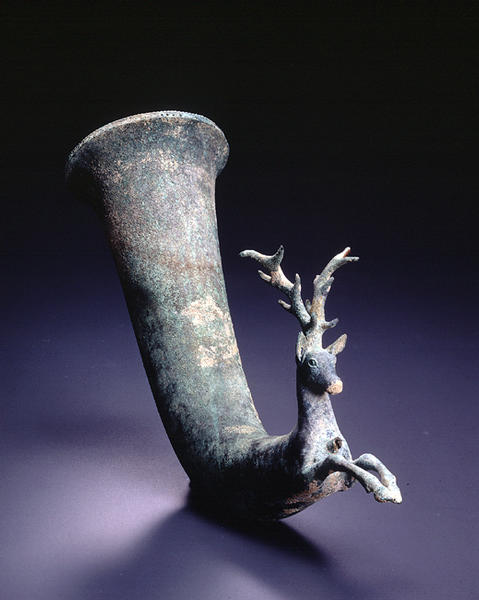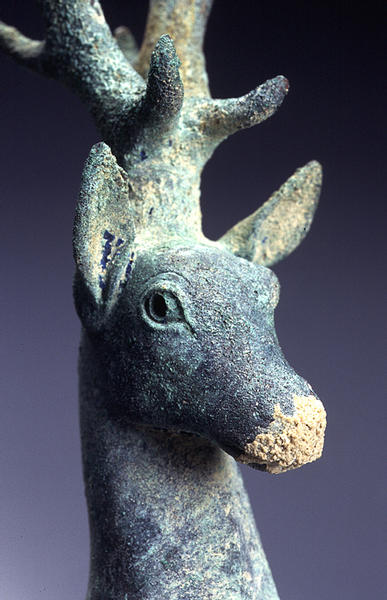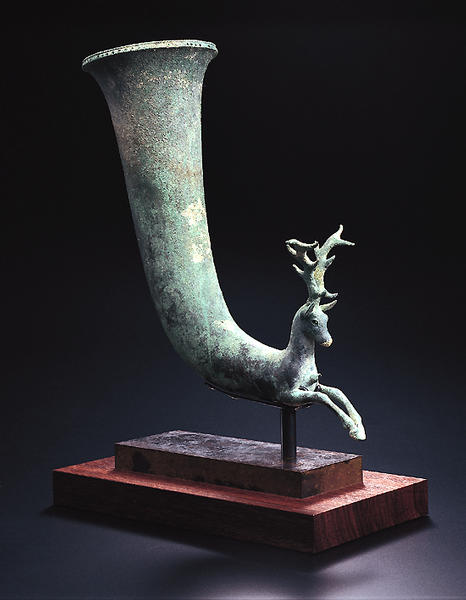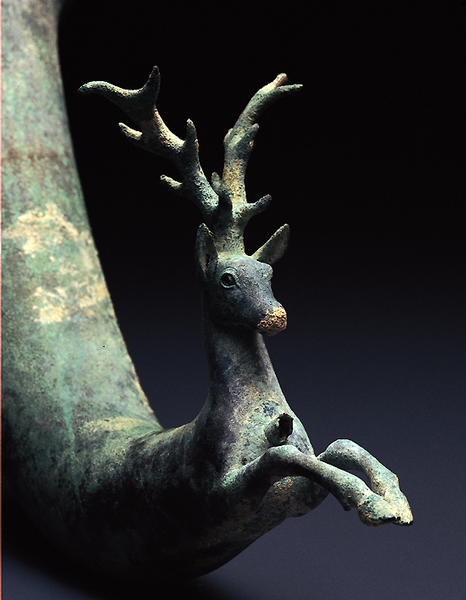牡鹿形リュトン
- 小アジア/黒海沿岸地域
- 前4世紀-前2世紀
- 青銅
- H-37 D-12 W-25.5
Catalogue Entry
This rhyton is an example of a special type of vessel that was used by the Greeks for religious rituals. The word rhyton derives from the Greek verb "to pour through," which accurately describes what happens when liquid is added to the rhyton's flared mouth, since it immediately passes through the vessel and streams out through the open spout on the other end.
This slender horn tapers from a circular mouth with an everted lip to the exquisitely sculptured rendition of the protome (forepart) of a bounding stag. The rim of the mouth is beaded and the lip is encircled by a band of pierced ovolos. The stag was rendered in the naturalistic style that was prevalent during the Classical period (480-336 B.C.). The animal's head is drawn back on its long neck, its ears perked upright. The eyes, bordered by raised lids and topped by finely incised brows, look to the right. The upper lip of the closed muzzle extends over the lower, from which it is separated by lips with down-turned corners. A fine V is incised above the nostrils. A magnificent rack of antlers rises from a single trunk on top of the stag's head before separating into two branches of thick horns. A short, round spout emerges from the stag's chest, just above its extended front legs, which end in delicate, cloven hooves.
Because the contemporary Achaemenid rhyton1 suited their purposes, the Greeks adopted it as their own, refashioning it to match Greek taste.2 The rhyton became especially popular in the cult of the Greek wine god, Dionysos, who is frequently depicted holding one. Stag rhyta, however, which appeared in the Near East over a thousand years earlier and remained in use centuries later,3 may have been associated with Artemis, goddess of the hunt, who frequently appears with deer and stags.4
KM
Even though no seams are visible, the rhyton consists of several parts: horn and protome, both hammered; a cast head with horns; two cast legs; and a spout. All parts are attached with solder.
PM
1. See Ortiz 1994, no. 206, for a contemporary Achaemenid stag rhyton.
2. Hoffmann 1961, pp. 23-24.
3. See Muscarella 1974, no. 123, for a Hittite stag rhyton of 1400-1200 B.C.; and Pfrommer 1993, no. 74, for a Parthian example made between 50 B.C. and A.D. 50.
4. LIMC 2 (1984), pp. 618-753, s.v. Artemis (by Lilly Kahil), especially no. 1334, a fragment of a contemporary Apulian volute krater on which Artemis's wagon is drawn by two stags.
解説(春の玉手箱)
しなやかな胴体を辿っていくとつぶらな眼差しに出合う。このリュトンはギリシア古典期(前四八〇-前三三六)に流行した写実的な様式で表現された、ギリシア人が儀式に用いた特別な容器である。リュトンという名称は,「流出する」というギリシア語の動詞から派生した言葉であるが,その字義の通り,液体を角状の本体に入れるや,胴部を通過して牡鹿の胸にある注口から液体が流れ出る仕組みとなっている。跳躍する若い牡鹿の胴体がカーヴを描きながら広がってゆく姿に、春の訪れを告げるホルンの潤いのある響きまでが聞こえてくるようである。
解説(古代バクトリア遺宝展)
前4世紀頃
青銅
高37.0 cm 幅25.5 cm 口径11.7-12.0 cm
このリュトンは牡鹿の前半身をその先端に作り出し、器口から入れたワインはその胸につけられた注口から迸り出るようになっている。この鹿はやや太めではあるが角が複雑に枝分かれした麕鹿の類を表していると考えられる。今は穴となっている眼の瞳孔には石あるいはガラスの象嵌が施されていたと思われ、眼を後方に巡らせている。マケドニアの一つの都ペラから出土したモザイクには、2人の男性がこのような太い角をもった麕鹿を狩っている姿が描かれているが、その鹿も眼を後方に巡らせている。
このリュトンに見られる脚を前にそろえる鹿の姿はギリシャ陶器に古くから描かれてきた、狩られた鹿あるいは捧げられた鹿の図像に通じている。これらは狩猟の女神アルテミスや酒の神ディオニュソスに伴う図像であるが、このリュトンもこれらの神々の信仰と何らかのかかわりをもっていたものと思われる。やや喇叭状に広がった口縁に沿って卵鏃意匠が施され、各々の卵形の中央に小さな穴があけられ細い繊維のようなものが嵌め込まれているものがあることから見て、木蔦などの作り物を取り付けたものであったと想像される。木蔦意匠はギリシャ陶器の口縁や肩に多く見られるものであり、特にトラキアやヘレニズム期の西アジアの金属製のリュトンの口縁はしばしば浮彫の木蔦の葉と実で装飾されている。イタリア・タラント遺宝には、同時期の青銅器で木蔦の作り物の装飾を施したものが存在したことを窺わせるものが見られる。
Catalogue Entry(Bac#021)
ca. 4th century B.C.
Bronze
H. 37.0 cm, W. 25.5 cm, Mouth dia. 11.7-12.0 cm
The tip of this rhyton is formed in the shape of the forequarters of a stag, and wine that had been poured into the rhyton's opening would then be served out of the spout that protrudes from the stag's chest. This stag has somewhat thick horns with complex branches, and is thus thought to depict a type of Reh deer. The eyes which are holes today would have been originally inlaid with either stone or glass eyeballs, and both eyes are turned toward the back. Mosaics excavated at Pella, one of the capitals of Macedonia show two men hunting a deer with this kind of thick horns, and the eyes on that deer also both turn toward the back.
The stag's leg-extended pose seen on this rhyton had long been depicted on Greek pottery, and this iconography shows either a hunted deer, or an offertory deer. This iconography accompanies images of either Artemis, goddess of the hunt, or Dionysus, god of wine, and it is thought that this rhyton had some connection with the worship of these gods. The slightly flaring mouth rim is decorated with an egg and dart pattern, and the center of each of the eggs is pierced with a small hole which then would have been inlaid with a small fiber. We can imagine that this would have been the attachment for some ornament in the shape of vine. Vine imagery can be frequently seen at the rims or shoulders of Greek pottery, and this is especially the case in metal rhyta from Hellenistic west Asian and Thrace which frequently have relief patterns of ivy leaves and fruit around their mouths. Among the Tarente treasures of Italy, there is also a bronze vessel from this period which has three-dimensional ivy decorations.
牡鹿形リュトン
ラッパ状の角杯は湾曲しながら先端に向け徐々に窄まり、途切れることなく牡鹿の体躯と化している。彼は前脚をきちんと揃えて下に曲げ器全体でゆるいS字形を描きながら、立派に成熟した角を上に掲げるかのように、顎をひき頸を屹立させて神妙な雰囲気を漂わす。
この牡鹿はただものではない。両角の根元は一本の幹。それが二股に分かれ、更に複雑に枝分かれした聖樹を戴いている。角杯内壁の赤く塗られた漆喰は大きな謎。ワインを満たした器として神殿あるいは墓に納められたのか。
Stag Rhyton
The trumpet-shaped vessel curves as its diameter narrows toward the tip and seamlessly emerges as the body of the stag. With its front legs neatly held together with the tips of the hooves pointed down so that the whole vessel forms an S-shaped curve, the stag's pose exudes a feeling of solemnity, chin pulled back and head arched as if to raise high its beautifully developed antlers.
But this is not just the figure of a stag. Its two antlers are each made with a trunk tube which branches into two and then further branches, suggesting a sacred tree. The red-painted plaster covering the inner walls of the rhyton remains a mystery. Possibly as a vessel filled with wine it may have been offered to a shrine or buried in a grave.



